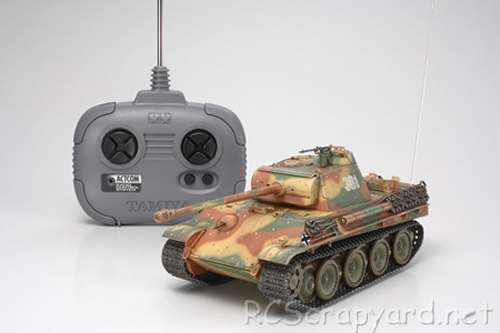

|
|
|


|
Tamiya German Panther Type G - 48205 (Radio Controlled Model Review)1/35 Scale Electric Tank -
Released by Tamiya on March 18, 2008, the 1/35 R/C German Panther Type G Late Version (#48205) came with new parts for lower hull to enable installation of running gear and internal mechanics, Newly-developed FM 27MHz R/C system enables forward/reverse, right/left turning, pivot turning, turret rotation and gun elevation, all controlled via directional pads on the included transmitter. 4 frequencies included (26.995, 27.045, 27.145, 27.195). Compact gearbox with 90:1 gear ratio controls both tracks for realistic tank movement. Compact receiver included. 006P(9V)/6F22 battery for transmitter and four R03/AAA/UM4 batteries for the tank separately required. High level of detail including hull-mounted tools and cables, late type main gun mantlet and turret mounted machine gun, just like the static model version.
▼ Scroll Down for More Images ▼
Rating: 4
|








|
|
|

|

|
Hints, Tips and Information
How to avoid Radio Interference
1/ The first consideration when installing your Receiver into your Electrically Powered Model is to make sure it is well away from the Negative Battery terminal, and the Motor. The Magnetic field can cause stuttering type interference at times of high current draw (i.e., Fast Acceleration) |









|






|
|
|
|
Hints, Tips and Information Rechargeable Batteries
|
|
Hints, Tips and Information
Radio Frequencies - be Careful be Safe
After buying your first car, it won't be long before you need more than simply bashing around the back yard, or out on the street. So you will be looking around to find a club that is not too far away where you can do some serious racing. |
|
RC Models:
|
Radio & Motors: |
Other
Accessories: |